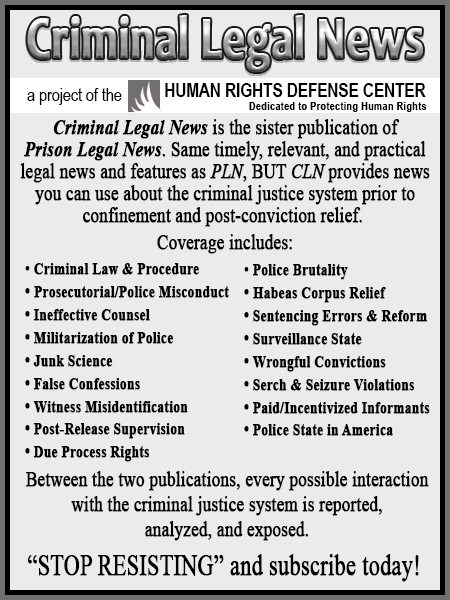Pennsylvania Supreme Court Announces Framework for Determining Whether State of Mind Exception to Hearsay Rule Applies to Out-of-Court Statements, Dual-Purpose Statements Generally Inadmissible
by Matt Clarke
The Supreme Court of Pennsylvania held that a note implicating the husband of a woman who was drowned the day after she wrote it was inadmissible hearsay, after it had announced a new analytical framework for determining whether the state of mind exception to the hearsay rule applies to out-of-court statements.
Joseph Bernard Fitzpatrick, III, and his wife, Annemarie, were riding an all-terrain vehicle (“ATV”) through a deep part of a creek when, according to Fitzpatrick, it flipped backwards and threw both of them into the creek. She had severe injuries and drowned. He had no major injuries.
The Pennsylvania State Police (“PSP”) believed the death was accidental. The coroner’s office determined the cause of death was drowning and released the body to a mortician without performing an autopsy. Two days after the drowning, one of Annemarie’s co-workers called the PSP to report having found a note in her day planner implicating her husband in her death. The note was dated the day before her death and signed by Annemarie. It read, “If something happens to me—JOE.” When the PSP examined her computer, they discovered an email Annemarie had sent to herself with a subject line, “if something happens to me,” and text, “Joe and I are having marital problems. Last night we almost had an accident when a huge log fell on me. Joe was on the pile with the log and had me untying a tarp directly below.”
Annemarie’s body was autopsied after it had been embalmed. The forensic pathologist found a broken rib and injuries to her head, neck, torso, buttocks, lower back, and all of her limbs. She concluded that the circumstances surrounding the death were suspicious, but the manner of death could not be determined as the injuries could have happened during resuscitation attempts or embalming.
Annemarie had a $1.7 million life insurance policy with Fitzpatrick as the beneficiary. The PSP found he had searched online for “life insurance review during contestability period” and “polygraph legal in which states” shortly before Annemarie’s death. A PSP accident reconstructionist was unable to reconstruct Fitzpatrick’s version of the accident but had used the non-operational waterlogged ATV in the attempt.
Fitzpatrick was charged with murder. A pretrial judge ruled that the note was admissible under the “state of mind” exception to the rule against hearsay to prove the truth of the facts asserted under Pa.R.E. 803(3). A different judge presided over the jury trial during which Fitzpatrick was found guilty and sentenced to life in prison. That judge denied a postconviction motion challenging the admission of the note. On appeal, the Superior Court upheld the denial of the postconviction motion.
On further appeal, the Supreme Court held that the note was inadmissible hearsay.
The Court began its opinion by acknowledging “the difficulties posed by hearsay and its exceptions.” Rule 801(c)(1)-(2) defines hearsay as “a statement … the declarant does not make while testifying at the current trial or hearing … [that’s offered] in evidence to prove the truth of the matter asserted.” Such statements are inadmissible unless covered by an established hearsay exception. See Rule 802.
Because there is so much confusion about hearsay, the Court provided the following example to help provide clarity. If a witness tells a police officer that “the killer had green eyes” and if that statement is offered into evidence to prove the killer’s eyes were green, that would constitute hearsay. On the other hand, if the statement were used for a purpose other than establishing the truth of the statement—for example, demonstrating the effect it had on the officer by showing it caused him to prepare a photo array of only people with green eyes—then it wouldn’t be hearsay and thus admissible for that non-truth proving purpose.
The Court observed that Annemarie’s note was entered into evidence as admissible hearsay under the “state of mind” exception to the rule against hearsay. As such, the jury was allowed to consider the existence of and allegation contained in the note as proof that if something happened to Annemarie, Fitzpatrick was responsible. The Court explained that this allowed the jury to “infer Fitzpatrick’s mens rea from Annemarie’s subjective belief, effectively enabling her to identify Fitzpatrick as her killer from the grave….” The Court held that the note was not admissible under the “state of mind” exception to the rule against hearsay.
The Court distinguished between the “two ways a declarant’s state of mind can be invoked as a basis for admitting a declarant’s out-of-court statement in a legal proceeding,” lamenting that both lawyers and judges often conflate them. The purpose for which the statement is offered is the critical difference between the two, according to the Court.
The first type involves a statement that’s not being offered for its truth but rather “to show the mental state of the person making” it. Commonwealth v. Auker, 681 A.2d 1305 (Pa. 1996). It’s admissible only for that limited purpose and not for the truth of the statement. For example, a person’s statement “I can fly to the moon” wouldn’t be hearsay if offered to show the speaker’s state of mind (possibly delusional) because it’s not being offered to prove the truth of the statement, i.e., not being used to prove that the speaker can actually fly to the moon.
The Court stated that Annemarie’s note implicates the second type of state of mind admission of hearsay—“the out-of-court statement is offered to prove the truth of the matter asserted.” The Court explained that these “then-existing state of mind statements” are excepted from the hearsay rule because they possess the “special assurance of reliability” because of “their spontaneity and resulting sincerity.” McCormick on Evidence § 274 (8th ed.).
Rule 803(3) governs the admissibility of then-existing state of mind statements, which states: “Then-Existing Mental, Emotional, or Physical Condition. A statement of the declarant’s then-existing state of mind (such as motive, intent or plan) or emotional, sensory, or physical condition (such as mental feeling, pain, or bodily health), but not including a statement of memory or belief to prove the fact remembered or believed unless it relates to the validity or terms of the declarant’s will.” The Court stressed that this exception applies only to statements regarding the declarant’s then-existing state of mind, “not someone else’s state of mind or condition.” The Court added that the exception doesn’t permit “an out-of-court statement of one person to prove the intent, motive, feelings, pain, or health of another person.”
The Court stated that Annemarie’s note contains both a statement demonstrating her then-existing state of mind but also a factual assertion, viz., if something happened to her, Fitzpatrick would be the perpetrator. The note clearly indicates her state of mind when she wrote it; she was apprehensive of Fitzpatrick. Had that been the only statement in the note, it would be admissible hearsay (subject to other rules of evidence), according to the Court. However, the note also contains the factual assertion that if anything happens to her, Fitzpatrick would be the perpetrator. This fact-based portion of the statement, when offered for the truth of the matter asserted, is inadmissible hearsay, the Court explained. See Commonwealth v. Chmiel, 738 A.2d 406 (Pa. 1999) (generally, each portion of a statement must be admissible in order for the entirety of it to be admitted).
The Court stated the question then is whether the compound statements in the note “are nevertheless admissible in their entirety as state of mind evidence under Rule 803(3).” These types of “dual-purpose statements” that accuse a person from the grave or establishing another person’s state of mind while also including the then-state of mind of the declarant have perplexed courts for many years, the Court noted. In fact, the Pennsylvania Supreme Court has issued conflicting decisions in recent years on this issue, whereby in some cases, the Supreme Court has taken a broad view on admissibility, but in others, it has taken a more limited view on admissibility, the Court acknowledged, adding it “has caused some confusion for the bench and bar in this complex area of evidentiary law.”
To resolve the confusion, the Court announced: “to ensure clarity going forward, we set forth the general inquiry courts must undertake when contemplating the admissibility of out-of-court statements proffered to the court for admission as state of mind evidence.”
The Court instructed as follows. First, the court must determine the reason the evidence is offered. If not for the truth of the matter asserted, it’s not hearsay and can be admitted. But if the statement is being offered for a truth purpose, the next step is for the court to decide whether it’s relevant. Finally, if relevant and a single-purpose statement regarding the declarant’s state of mind, it’s generally admissible. But if it’s a dual-purpose statement, it’s generally inadmissible.
After having announced this new analytical framework, the Court applied it to Annemarie’s note. The Court stated that the note is undeniably relevant because Fitzpatrick claims that she was not murdered but instead died in an accident. See United States v. Brown, 490 F.2d 758 (D.C. Cir. 1973) (explaining victim’s state of mind generally not relevant except when defendant claims (1) self-defense, (2) deceased committed suicide, or (3) deceased died in an accident).
Next, the Court assessed the purpose for which the note was offered into evidence and, upon a review of the trial record, concluded that the note unquestionably was offered to establish the truth of the statement therein. The Court then stated that the note is a dual-purpose statement that includes Annemarie’s then-state of mind but also “identifies Fitzpatrick as her assailant and tangentially implicates his state of mind.” Thus, the Court held that the latter portion of the note is hearsay, and the entire note is inadmissible under the state of mind exception.
The Court determined that the erroneous admission of the note was not harmless. The prosecutor repeatedly argued that the note proved the truth of the matter asserted in it. The note was not cumulative of other evidence, and the only other evidence that the death was murder was weak—the testimony of the pathologist and accident reconstructionist. The pathologist could not identify the manner of death, and the reconstructionist used a water-logged, nonfunctioning ATV in his attempts to reconstruct the accident. As a result, the Court concluded there wasn’t overwhelming evidence of guilt, so the error was not harmless.
Accordingly, the Court vacated the judgment of sentence and remanded for a new trial. See: Commonwealth v. Fitzpatrick, 255 A.3d 452 (Pa. 2021).
As a digital subscriber to Criminal Legal News, you can access full text and downloads for this and other premium content.
Already a subscriber? Login
Related legal case
Commonwealth v. Fitzpatrick
| Year | 2021 |
|---|---|
| Cite | 255 A.3d 452 (Pa. 2021) |
| Level | State Supreme Court |
| Conclusion | Bench Verdict |





